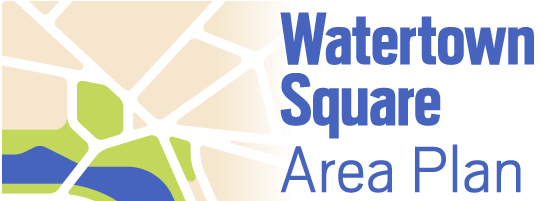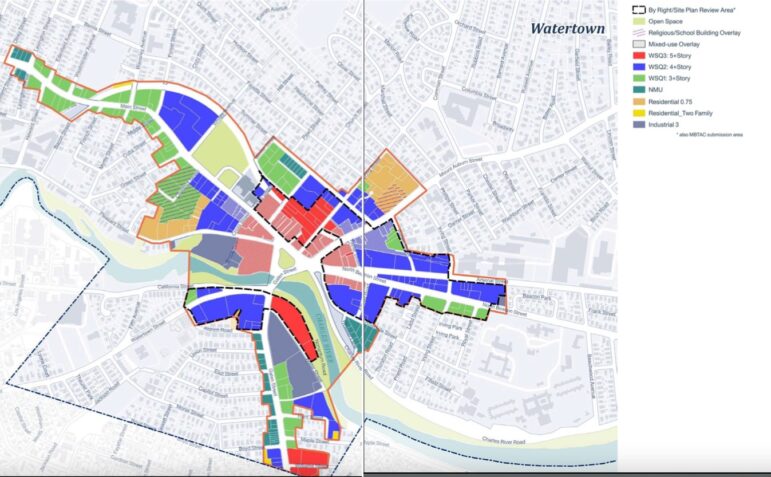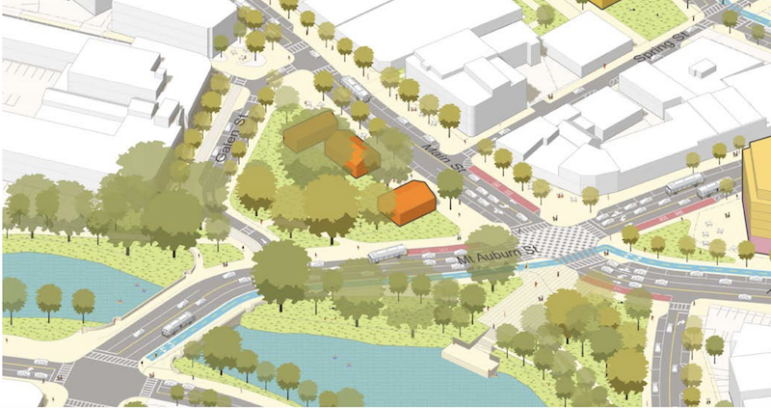
Traffic flows and affordable housing remained front and center issues for city officials who gathered on June 27th to discuss — for the second time this year — the comprehensive redevelopment plan for Watertown Square. The discussion among the City Councilors and Planning Board members circled around what the sticking points of the Watertown Square Area Plan were and how, exactly, they should move forward.
“Watertown Square is a failed concept. It’s been failing for 30 years. We need housing. We need upstairs neighbors,” Councilor John Gannon stated. “There’s a hole in Watertown, and that is Watertown Square.” Between empty spaces, old buildings with no elevators, and no incentive for business owners to invest, it’s unsurprising that the square needs “a facelift,” as Councilor John Airasian put it.
Town Manager George Proakis acknowledged the intense interest the development plans were generating in the community.
“This is the most robust public involvement process I have ever been involved in,” he noted at the top of his remarks, noting there were more than 200 people at the kickoff, 275 participants in the charrette, 240 people at the previous February meeting, and 334 participants in the April meeting. Those previous two meetings generated close to 1,000 comments. That evening, there were around 100 people in the room at Watertown Middle School and another 75 watching on Zoom.
It’s easy to see why. The square, even in its current state, is not only the center of the town but the center of people’s lives, and everyone agreed that Watertown Square’s current state is a far cry from its true potential. Proakis, quoting Winston Churchill, called this meeting and this draft of the proposal “the end of the beginning” before also emphasizing that what the council and planning board were looking at was “not zoning. It’s not an engineering design. It’s a plan.”
The crux of the discussion revolved around transportation and traffic management, as well as an expressed desire to offer more housing and specifically more affordable housing. But as planning board member Payson Whitney noted, just because they could build more housing doesn’t mean it would drive prices down. “There’s affordable housing, and then there’s housing affordability,” he said. “I don’t want people to think this is a panacea for housing affordability.”

Councilor Tony Palomba said more incentives will allow for more affordable housing, something Councilor Lisa Feltner and Planning Board member Abigail Hammett also supported. Palomba stressed that while current plans include housing for individuals living at 80 percent of the area median income (AMI), there remains a critical need to address the housing requirements of those with even lower incomes, highlighting those in professions such as restaurant workers who face significant housing challenges.
Councilor Gannon echoed these sentiments, pointing out the broader issue of a housing shortage in Massachusetts. He warned that the state is losing younger populations who are vital for the local and state economy due to the high cost of living. “We have a demand. We have a large amount of housing needed. We need affordable housing. We don’t have it here,” he said.
Planning Board member Rachel Sack, in a written statement, said she was concerned about some important information that she did not yet see in the plan in terms of housing.
“There is no question that the Commonwealth is experiencing a housing crisis and we are in a unique position to play an important role in mitigating this,” she wrote. “I believe, however, that the plan lacks information to show the trade offs between different housing scenarios, traffic volumes, and developed land versus green space. I think the plan is quick to jump to a high level of housing, which, while absolutely needed, does not fully regard the impact it will have on living and working in our city.”
Airasian was slightly more cautious about the plan than several of his colleagues, warning of “sweeping changes that could be detrimental to the community as a whole.”
“I think that we can get more housing and get to where we want to be with the way things are presently,” he said.

Councilors Emily Izzo and Lisa Feltner both pointed out the potential for increased traffic and inadequate parking as a result of new developments. Would the square become more efficient or just create new bottlenecks? Changing traffic patterns and making congested areas even more congested was a big concern. Councilor Vincent Piccirilli questioned the impact of redesigning Watertown Square’s traffic patterns in terms of creating significant delays through the square to the Mass Pike.
There were concerns about the long-term sustainability of traffic changes, particularly in relation to public transportation. Piccirilli also raised the issue of how traffic pattern changes would interact with existing and planned public transit services.
“Should this plan be explicit in stating that we will seek to improve public transit service in Watertown Square?” he asked, highlighting the need for an integrated approach that considers both vehicular and public transit systems.
As Proakis pointed out in his opening remarks, any approved plan still has a long way to go: Zoning, more public hearings, refinement of the plan, designing and planning, and further meetings with neighbors to the sites would all be next steps. But he remained adamant that this was a good thing.
“This is about trying to take back your downtown,” he said.
“It’s clear that Watertown’s growing up,” said Whitney. “I think the draft plan is close to finished. I think with a few more refinements we can get to that end of the beginning.”
The boards did not vote on June 27, and another community meeting will be scheduled in July.
See more about the Watertown Square Area Plan at https://watertownsquareimprovements.com/
This is what I heard at the June 27 hearing that I applauded:
1. Recognition by several councilors of the fact that “green space” is an “infrastructure” issue, and not just a matter of aesthetics. This was further supported by one Planning member’s recommendation that a top-notch landscape design company be hired, and that we should far surpass the rather ordinary use of greenery in recent developments. If we are proud of our “sustainable” approach, let’s extend it from mechanicals to landscape design.
2. A councilor’s suggestion that we approach the number of units in a “staged” manner, rather than automatically committing to 3300. Let’s see how well we do with 1700 units, and be flexible enough that we can either stop or go further, depending on how well we achieve goals.
3. A councilor’s concern about adding housing for those at the middle or lower end of average area income. These folks will not be helped by the current project. Just as we have expanded this MBTA project to include Watertown Square redevelopment, can we also be moving ahead on some plan for current residents who cannot afford to continue living here , or those who may work here but cannot live here —regardless of how many new units are added under this project.
4. The President’s deferral of a vote until after the community has a chance to express their views, at a July meeting. We have a new city position for someone in charge of communication between the City government and the community. Let’s use all avenues to reach the public, including the public who are generally too busy to follow local government. Are we reaching out to groups which are not traditional followers of city government? Do we have a board or flyers at the Farmer’s Market, at Project Literacy, eg? (Please excuse me if we already do.)
Thank you.
For those who haven’t understood this (although it has been repeated 1000 times) – neither 1,701 nor 3,331 “unit capacity” numbers will actually be built in the next several years because it would require the impossible – i.e. all property owners in the Plan area tearing down what is on their land today and building housing on it, up to the limits of zoning.
This is why there is no opportunity to ” see how well we do with 1700 units” because all those units won’t be built, and certainly not in the same time frame.
The point is to remove any special permit requirements from the Plan area (excluding specific historic buildings), enabling the construction of housing “by right” according to the new zoning. Doing this may change the economic value of the relevant properties, which COULD enable some of that land to be sold for redevelopment. Only after that could any new housing be built, on land which today holds (for example) an auto parts business.
It is not the city’s responsibility to force people to pay attention to this process, which has been very widely promoted. IT IS THE RESPONSIBILITY OF INDIVIDUAL CITIZENS to pay attention and put the TIME and EFFORT into learning what their city government is doing. In this case, the Watertown Square Area Plan process has been ongoing for almost a year. For those who refuse to learn modern methods of communication, that’s their choice but they are thereby choosing to be outside this process. And if you don’t have time or attention span to learn about the basics of this Plan, why are you commenting on it?